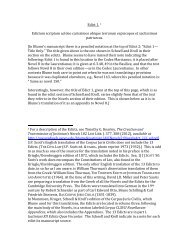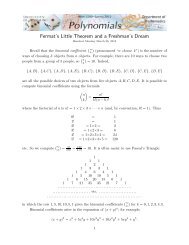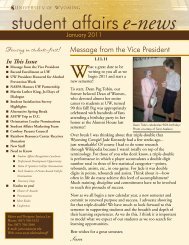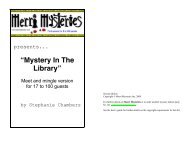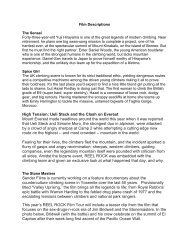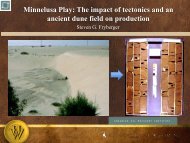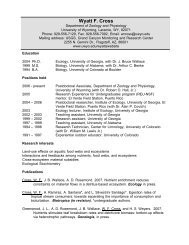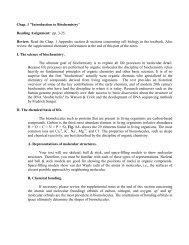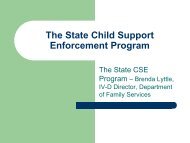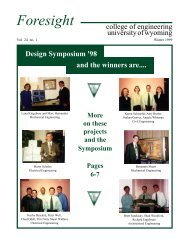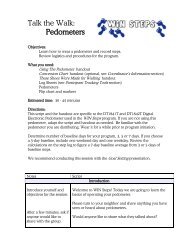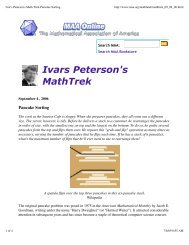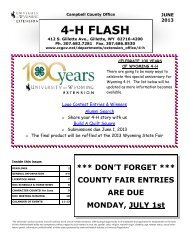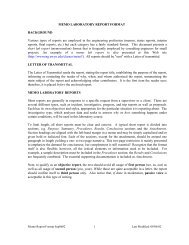microhabitat selection for nesting and brood-rearing by the greater ...
microhabitat selection for nesting and brood-rearing by the greater ...
microhabitat selection for nesting and brood-rearing by the greater ...
Create successful ePaper yourself
Turn your PDF publications into a flip-book with our unique Google optimized e-Paper software.
82 CHRISTOPHER P. KIROL et al.<br />
ratios includes 1 (Table 6). The statistically supported variables<br />
were ARTRW, CHEAT, GANDR, GRSCVR, LITTER,<br />
SAGECVR, <strong>and</strong> VOBST, with relative importance weights<br />
from 0.6 to 1.0. Nest <strong>selection</strong> was positively related to <strong>greater</strong><br />
grass cover, litter, sagebrush cover, <strong>and</strong> visual obstruction.<br />
For every 10% increase in sagebrush cover, <strong>the</strong> likelihood of<br />
sage-grouse <strong>nesting</strong> increased <strong>by</strong> approximately 10% (Fig.<br />
1). When compared to available habitat, nest <strong>selection</strong> was<br />
TABLE 4. Means (± SE) <strong>for</strong> all variables supported in <strong>the</strong> final<br />
AIC c models to assess sage-grouse <strong>microhabitat</strong> <strong>selection</strong> during<br />
<strong>nesting</strong>, early <strong>brood</strong> <strong>rearing</strong>, <strong>and</strong> late <strong>brood</strong> <strong>rearing</strong>, south-central<br />
Wyoming, 2008 <strong>and</strong> 2009.<br />
Variable category/name<br />
Grouse locations R<strong>and</strong>om locations<br />
Mean ± SE Mean ± SE<br />
Nest<br />
Cover (%)<br />
Gravel <strong>and</strong> rock 2.8 ± 0.6 7.5 ± 1.0<br />
Litter 45.1 ± 1.7 31.6 ± 1.7<br />
Sagebrush 39.0 ± 1.4 25.2 ± 1.0<br />
Total grass 17.5 ± 1.0 16.6 ± 1.2<br />
Visual obstruction (dm)<br />
Robel pole 3.8 ± 0.2 2.8 ± 0.1<br />
Early <strong>brood</strong>-<strong>rearing</strong><br />
Cover (%)<br />
Perennial grass 14.7 ± 1.5 9.6 ± 0.8<br />
Sagebrush 35.3 ± 3.0 22.5 ± 2.2<br />
Height (cm)<br />
Perennial grass 17.7 ± 0.8 18.5 ± 1.1<br />
Late <strong>brood</strong>-<strong>rearing</strong><br />
Cover types (%)<br />
Gravel <strong>and</strong> rock 4.4 ± 1.0 10.0 ± 1.8<br />
Sagebrush 37.7 ± 2.8 21.5 ± 1.7<br />
Perennial grass 17.4 ± 1.8 12.3 ± 1.6<br />
Biological soil crust 0.3 ± 0.1 1.1 ± 0.2<br />
Density (plants/m 2 ) 2.3 ± 0.14 2.5 ± 0.3<br />
Shrub<br />
Height (cm)<br />
Perennial grass 20.2 ± 0.9 21.8 ± 2.5<br />
Sagebrush 40.8 ± 2.6 25.9 ± 2.3<br />
negatively related to <strong>the</strong> presence of cheatgrass <strong>and</strong> Wyoming<br />
big sagebrush (Table 6). Cheatgrass occurred at 6% of <strong>the</strong> nest<br />
locations <strong>and</strong> 19% of <strong>the</strong> corresponding r<strong>and</strong>om locations.<br />
Wyoming big sagebrush occurred at 46% of our r<strong>and</strong>om locations<br />
but only at 35% of our nest locations. Conversely, mountain<br />
big sagebrush occurred at 32% of our r<strong>and</strong>om locations<br />
<strong>and</strong> 50% of our nest locations.<br />
SELECTION OF HABITAT FOR EARLY<br />
BROOD-REARING<br />
All of <strong>the</strong> predictive variables in our final model <strong>for</strong> early<br />
<strong>brood</strong> <strong>rearing</strong> were continuous <strong>and</strong> included canopy cover<br />
<strong>and</strong> height of perennial grasses <strong>and</strong> canopy cover of sagebrush<br />
(Table 4). No variables grouped in Early-<strong>brood</strong> III<br />
were predictive. Consequently, <strong>the</strong> final level of model <strong>selection</strong><br />
<strong>for</strong> early <strong>brood</strong> <strong>rearing</strong> contained a combination of<br />
<strong>the</strong> top models from Early-<strong>brood</strong> I <strong>and</strong> Early-<strong>brood</strong> II. Early<strong>brood</strong><br />
I contained 8% <strong>and</strong> Early-<strong>brood</strong> II 37% of <strong>the</strong> pure<br />
variation. The top model had good support (w i = 0.61) <strong>and</strong><br />
was 2.4 times more likely than <strong>the</strong> second model to best explain<br />
<strong>selection</strong> of habitat <strong>for</strong> early <strong>brood</strong>-<strong>rearing</strong> (Table 7).<br />
Variables composing <strong>the</strong> top model included SAGECVR,<br />
PERGRS, <strong>and</strong> GRSHGHT, which had RI values of 1.0, 1.0,<br />
<strong>and</strong> 0.9, respectively. Early in <strong>brood</strong>-<strong>rearing</strong>, <strong>brood</strong>ing hens<br />
selected habitats with <strong>greater</strong> cover of sagebrush canopy,<br />
<strong>greater</strong> cover of perennial grass, <strong>and</strong> shorter grass than in<br />
available habitat (Table 6). A 10% increase in sagebrush<br />
cover increased <strong>the</strong> odds of use <strong>for</strong> early <strong>brood</strong> <strong>rearing</strong> <strong>by</strong><br />
approximately 20% (Fig. 1). Although <strong>the</strong> means <strong>for</strong> both<br />
food <strong>for</strong>b cover <strong>and</strong> total <strong>for</strong>b cover were slightly higher at<br />
used than at r<strong>and</strong>om locations (6.7 ± 1.3% vs. 5.9 ± 0.7% <strong>and</strong><br />
7.5 ± 0.9% vs. 7.1 ± 0.7, respectively), inclusion of <strong>the</strong>se variables<br />
in <strong>the</strong> models was not supported.<br />
SELECTION OF HABITAT FOR LATE BROOD-REARING<br />
Continuous variables that were predictive in our final<br />
model <strong>for</strong> late <strong>brood</strong> <strong>rearing</strong> included biological soil crust,<br />
gravel <strong>and</strong> rock, height <strong>and</strong> canopy cover of perennial<br />
grasses, height <strong>and</strong> canopy cover of sagebrush, <strong>and</strong> shrub<br />
density (Table 4). There were no categorical variables that<br />
TABLE 5. Top <strong>and</strong> competing (AIC c ≤ 2.0) models best explaining <strong>the</strong> sage-grouse’s <strong>selection</strong> of nest <strong>microhabitat</strong> in south-central<br />
Wyoming, 2008 <strong>and</strong> 2009. Nest I, II, <strong>and</strong> III represent <strong>the</strong> hypo<strong>the</strong>sis sets used in sequential modeling.<br />
Model (averaged) Ka b AIC w ROC c i c<br />
[SAGECVR, SHRUBDEN, VOBST] + [GRSCVR, LITTER] + [ARTRW, CHEAT, GANDR] Nest I Nest II Nest III 11 0.00 0.44 0.84<br />
[SAGECVR, SHRUBDEN, VOBST] + [LITTER] + [ARTRW, CHEAT, GANDR] Nest I Nest II Nest III 10 1.53 0.20 0.84<br />
[SAGECVR, SHRUBDEN, VOBST] + [GRSCVR, LITTER] + [ARTRW, BIOCRUST, CHEAT,<br />
Nest I Nest II 12 1.69 0.19 0.85<br />
GANDR] Nest III<br />
Null 1 77.20 0.00<br />
a Number of parameters with site <strong>and</strong> year included in all models.<br />
b Lowest AICc = 244.84 <strong>for</strong> nest.<br />
c Receiver operating curve (ROC) statistic indicating <strong>the</strong> true positive rate.



